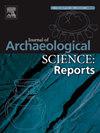Petrological characterization for material provenance of haniwa earthenware from mounded tombs in the Kibi region, Japan
IF 1.5
2区 历史学
0 ARCHAEOLOGY
引用次数: 0
Abstract
To determine the provenance of the materials used in the production of haniwa earthenware unearthed from mounded tombs (kofun) in the Kibi region (modern Okayama Prefecture) during the Kofun period (late 3rd – 6th century CE) of Japan, we carried out petrological analyses of haniwa sherds, including optical microscopy, X-ray diffractometry, X-ray fluorescence spectroscopy, and electron-probe analysis. The 25 haniwa sherds analyzed from 12 representative mounded tombs are composed of mineral and rock inclusions with variable grain size set in a clay matrix. The dominant inclusions are quartz, K-feldspar, and plagioclase, associated with minor amounts of amphibole, volcanic glass, and granitic rocks in all the haniwa sherds, and small amounts of hornfels, quartz rock, and accessory minerals, including mica, ilmenite, and chromite, in some of the sherds. Amphibole and plagioclase have compositional variations indicative of the mixing of tephra and granitic components. The compositions of volcanic glass inclusions are similar to those of the Aira-Tanzawa and Kikai-Akahoya tephras widely distributed in southwestern Japan. Bulk chemical compositions show magmatic differentiation trends, which are variable between individual tombs. From these results, it is concluded that the paste materials of haniwa in the Kibi region were commonly derived from weathered granitic rocks mixed with minor amounts of three widespread tephras. The variations of chemical and mineralogical compositions are probably the reflection of local geologic settings, suggesting the presence of specific mining sites of paste materials around each tomb. The mining sites could be located at the bases of hills of granitic rocks covered by widespread tephras and in some cases, near the flood plain of big river systems.
对日本木部地区土墩墓出土的谷和陶器进行岩石学特征描述以确定材料来源
为了确定日本甲文时代(公元 3 世纪晚期至 6 世纪)贵比地区(今冈山县)土墩墓(甲文)出土的花纹陶器的制作材料来源,我们对花纹陶器碎片进行了岩石学分析,包括光学显微镜、X 射线衍射仪、X 射线荧光光谱仪和电子探针分析。从 12 座具有代表性的土墩墓中分析出的 25 件谷和陶器由粘土基质中不同粒度的矿物和岩石包裹体组成。主要的包裹体是石英、钾长石和斜长石,在所有的花岗岩残片中还有少量闪石、火山玻璃和花岗岩,在一些残片中还有少量角闪石、石英岩和附属矿物,包括云母、钛铁矿和铬铁矿。闪石和斜长石的成分变化表明混合了火山碎屑和花岗岩成分。火山玻璃包裹体的成分与广泛分布于日本西南部的 Aira-Tanzawa 和 Kikai-Akahoya 喷发岩的成分相似。大块化学成分显示出岩浆分异趋势,不同墓葬之间存在差异。从这些结果可以得出结论,木部地区的花岗岩糊状材料通常来自风化花岗岩,并掺杂了少量三种广泛分布的辉绿岩。化学成分和矿物成分的变化可能是当地地质环境的反映,这表明每个墓葬周围都有特定的糊状物开采点。这些采矿点可能位于被广泛喷发的花岗岩覆盖的山丘底部,有些还位于大河水系的冲积平原附近。
本文章由计算机程序翻译,如有差异,请以英文原文为准。
求助全文
约1分钟内获得全文
求助全文
来源期刊

Journal of Archaeological Science-Reports
ARCHAEOLOGY-
CiteScore
3.10
自引率
12.50%
发文量
405
期刊介绍:
Journal of Archaeological Science: Reports is aimed at archaeologists and scientists engaged with the application of scientific techniques and methodologies to all areas of archaeology. The journal focuses on the results of the application of scientific methods to archaeological problems and debates. It will provide a forum for reviews and scientific debate of issues in scientific archaeology and their impact in the wider subject. Journal of Archaeological Science: Reports will publish papers of excellent archaeological science, with regional or wider interest. This will include case studies, reviews and short papers where an established scientific technique sheds light on archaeological questions and debates.
 求助内容:
求助内容: 应助结果提醒方式:
应助结果提醒方式:


